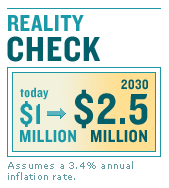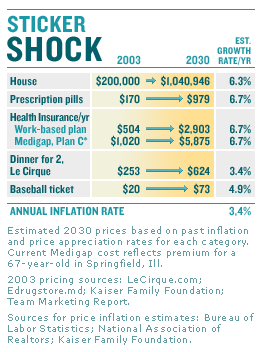NEW YORK (CNN/Money) – Welcome to a Friday night in 2030. You and your spouse, newly retired, decide to go out to dinner and a movie. You figure the evening will cost you about $130.
That's right: $130, for two tickets and a modest dinner.
That $130 may seem shocking, especially since today that same date with your honey might cost less than $60.

But that's the difference 27 years can make once you factor in inflation. And it's something people forget at their peril when estimating retirement needs.
"People ignore inflation. They do straight-line projections," said certified financial planner Steven Kaye. That is, they may figure they'll need to draw down the same set amount of income every year -- say $70,000 -- instead of $70,000 that increases 3 percent a year.
That's why, if you're 40-plus today, that cool million you're hoping to have set aside for retirement may not go nearly as far as you think if you retire in 2030 or beyond.
Think about it. If your expenses continue to appreciate at their historic rates -- which may or may not be on par with inflation -- the dollar bite for expenses in nominal terms alone is likely to be bigger than you might expect.
- If home prices continue to appreciate at or near their historic annual rate of 6.3 percent, according to the National Association of Realtors, a home that today costs $200,000 might cost more than $1 million come 2030. And that dream retirement home that you're envisioning, which today might go for $500,000, would top $2.6 million.
- A solid, $21,000 mid-sized sedan like the Toyota Camry listed on KBB.com will be more like $34,000 -- and that's assuming only a 1.8 percent annual growth rate, according to the Bureau of Labor Statistics (BLS).
- And a box of prescription pills that runs $170 today is more likely to cost close to $1,000 in 27 years, given a 6.7 percent annual growth rate, according to the BLS.
Even the price tag for the so-called little things won't seem so small.
- Taking your grandchild to a baseball game -- which today might cost you $40 -- could set you back $146, given a 4.9 percent appreciation rate. And that's before the hot dogs.
- If you're still into artery clogging, a dozen Krispy Kreme doughnuts could cost you nearly $13, double the $6.50 you'll pay today.
- And if you normally rack up a $50 bill shopping for food, plan on paying something closer to $111, given a 3 percent annual appreciation rate for groceries, according to the BLS.
Consider lifestyle changes
In addition to inflation and general price increases, there is also a likelihood that consumer spending habits may change, and what you'll want and need may be very different from what current retirees desire.

Take health care. According to Rod Falcon, a research director at the Institute for the Future in Silicon Valley, retirees' perception of health care may be much broader than it is now. More than doctor and hospital visits, health care will encompass an emphasis on healthful living – getting exercise, eating organic foods, and using a wide variety products that promise health benefits.
"Don't underestimate the way you think about health and what counts as health," Falcon said. "The household health budget may expand."
Health care decisions are likely to be made in an environment marked by a decline in retiree benefits, increased health care costs, greater longevity, new health technologies and treatments, and very likely, uncertainty about the future of public programs such as Medicare and Social Security.
And you might want to smoke on this: The impetus to be healthy may not just reflect a love of life. There's likely to be even greater pressure to age well.
"Health status is going to be social status," Falcon predicts.
Make realistic estimates of your needs
So what does all this mean for your nest egg and your current savings contributions?
Even though it's quite an accomplishment to build up a $1 million nest egg, you might want to periodically double-check that that will really meet your needs. If it doesn't, you still have time to adjust your savings contributions to make up the difference.
To get a ballpark figure of what you'll need in retirement, typically you base your goal on the assumption that your nest egg together with other income sources such as Social Security will need to generate anywhere from 70 percent to 100 percent of your current income.
This is an exercise you might revisit every two to three years since your income can change significantly, and along with it your lifestyle and expenses, Kaye said.
 |
YOUR E-MAIL ALERTS
|
Follow the news that matters to you. Create your own alert to be notified on topics you're interested in.
Or, visit Popular Alerts for suggestions.
|
|
|
Say you want to replicate your annual income today of $70,000 when you retire in 2030 at age 67. And let's assume you'll live until age 90.
In nominal terms, by 2030, that $70,000 will really be $155,490, assuming a 3 percent annual inflation rate. And that number will continue to grow every year thereafter as you adjust for inflation.
To support those ever-increasing income needs, your nest egg should be about $1.7 million the day you retire. That assumes you'll receive Social Security but no pension. And it also assumes you'll run out of money by age 90.
If you want to push back retirement by five years, to 2035, you'll still need about $1.5 million. Need the equivalent of $100,000 a year by 2035? Plan to have close to $2.5 million on tap, more if you're going to cut out of the work force in 2030.
How much you'll need to save to meet your retirement goals depends on how big your nest egg is today; whether you expect to receive a pension; how conservative your investments; how much you estimate stocks and bonds will return in future years; and, lastly, whether you plan to run down your principal during retirement or leave a pot of money for your heirs
For help coming up with an inflation-adjusted goal for your nest egg, use CNN/Money's retirement planner. And to find out how much you'll need to save annually to meet that goal, try the savings calculator.

|

